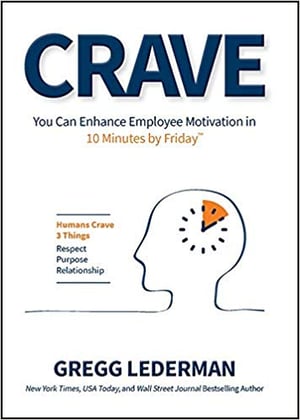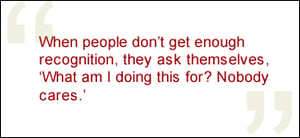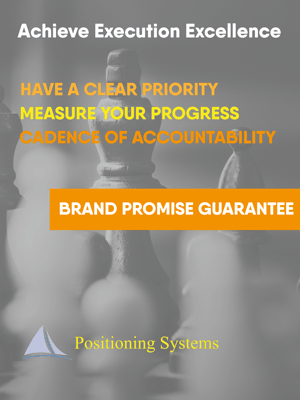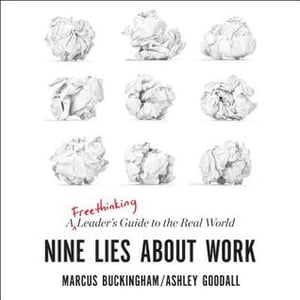 Gregg Lederman, CEO, speaker, and author of Crave: You Can Enhance Employee Motivation in 10 Minutes by Friday is excited.
Gregg Lederman, CEO, speaker, and author of Crave: You Can Enhance Employee Motivation in 10 Minutes by Friday is excited.
Employee engagement, he announced, has hit an all-time peak - 34%!
It’s the highest recorded measure of engagement since Gallup began reporting employee engagement in 2000.
"Actively disengaged" percentage is down to 13%, a new low!
Just think, only 13% of your team might be ACTIVELY DISENGAGED!
THREE LEVELS OF EMPLOYEE ENGAGEMENT
Why does employee engagement matter? Visit The Three Levels Of Employee Engagement And How They Impact Your Bottom Line.
This blog is a brief review of employee engagement, it’s how YOU, your team, and managers can significantly increase engagement in as little as 10 minutes a week.
Gallup has been measuring Employee Engagement since 2000. Engagement of employees is measured in three levels:
- Engaged employees work with passion and feel a profound connection to their company.
- Not engaged employees are essentially "checked out."
- Actively disengaged employees are more than unhappy at work.
How many of you can stomach paying 13% of your ACTIVELY DISENGAGED employees?
Wouldn’t it be better to free up their future?
Watch Greg’s two and half minute video:
WHAT EMPLOYEES CRAVE AT WORK?
Gregg Lederman shared a formula to achieve 91% employee engagement, something he’s achieved with 10 minutes by Friday with several large companies. More than 50% of these companies landed on the best places to work.
Happier, motivated employees, who feel successful in their role – results in better customer experiences.
Better customer experiences = higher company performance.
In order to achieve this level of engagement you need to understand what people crave at work?
- Respect
- Sense of purpose - do I make a difference?
- Relationship – with your boss
Is this different by generation? Do millennials want something different?
NO
We’re all more alike than unlike.
While Lederman explained why this works through the chemicals in the brain, Dopamine, Serotonin, and Oxytocin, I’ll spare this explanation. (Listen to GIVE EMPLOYEES WHAT THEY CRAVE MOST, Take Time to Properly Motivate Your Team Podcast)
STRATEGICALLY RECOGNIZE EMPLOYEES
How often do you and your team strategically recognize the people you work with?
As shared in Positive Reinforcement – What & How You Say It , Positive reinforcement needs to be delivered at a ratio of four to one. You need four positive reinforcements to one negative. How does your management team do in delivering positive reinforcement?
Lederman shared these 3 steps to recognizing employees:
- Tell the action
- Connect to a focus area
- Share the Impact
This latter step instills confidence and helps them to understand the purpose of their work.
For example, my marketing person posts links to my blogs on LinkedIn and Twitter. Here’s an example of how I might follow these 3 steps to recognize him. “Asif, last week the marketing links of my blogs you post generated a lead who’s interested in working with us on a project and possibly a long-term engagement. That can be a big boost for us to help me to expand your responsibilities and work as well. Thanks!”
%20Greg%20Lederman.jpg?width=2014&name=Recognition%20Is%20the%20Accelerator%20(Crave)%20Greg%20Lederman.jpg) Few if any of us follow these three steps to recognize our people on a consistent basis.
Few if any of us follow these three steps to recognize our people on a consistent basis.
Achieve 91% EMPLOYEE ENGAGEMENT – Create the Ultimate Habit
We’ve discussed habits a lot in these blogs. Habits are discipline in action!
To achieve 91% employee engagement Lederman shared these five steps to make strategically recognizing your employees a habit:
- Decide on a mindset: Behavior change requires a change in thinking, a rewiring of your brain. What will you need to think about differently or focus on to keep your new habit a high priority?
- Create routines and behaviors: The word habit implies “repeated action.” What are the repeated actions you will take to form your habit?
- Demonstrate willpower: Obstacles inevitably present themselves and willpower is needed to control your attention, emotions, and desires. What obstacles will challenge your willpower? What actions will you take to overcome obstacles?
- Focus on benefits: Look for small wins. Provide yourself with positive reinforcement. Pay attention to the personal and/or business impacts and results.
- Track effort daily: Daily effort tracking ensures you take a few seconds to reflect on the effort level you put toward your habit (not the results). If you keep trying, you will get better! Ask yourself every day, “Did I try?” There is an app for that! (I downloaded HabitBull and have been tracking my Meditation Habit since the Summit.)
Want to start strategically recognizing your employees? Download The Ultimate Habit™ Worksheet: Strategically Recognizing Employees Form.
 Growth demands Strategic Discipline.
Growth demands Strategic Discipline.
How can you build an enduring great organization?
You need disciplined people, engaged in disciplined thought, to take disciplined action, to produce superior results, making a distinctive impact in the world.
Discipline sustains momentum, over a long period of time, to lay the foundations for lasting endurance. It’s the framework for Good to Great:
- Stage 1: Disciplined People
- Stage 2: Disciplined Thought
- Stage 3: Disciplined Action
- Stage 4: Build Greatness
Positioning Systems is obsessively driven to elevate your teams Discipline. A winning habit -1.jpg?width=300&name=3%20Disciplines%20of%20Execution%20(Strategic%20Discipline)-1.jpg) starts with 3 Strategic Disciplines: Priority, Metrics and Meeting Rhythms. Your business dramatically improves forecasting, accountability, individual, and team performance.
starts with 3 Strategic Disciplines: Priority, Metrics and Meeting Rhythms. Your business dramatically improves forecasting, accountability, individual, and team performance.
Meeting Rhythms achieve a disciplined focus on performance metrics to drive growth.
Positioning Systems helps your business achieve these outcomes on the Four most Important Decisions your business faces:
|
DECISION |
RESULT/OUTCOME |
|
PEOPLE |
|
|
STRATEGY |
|
|
EXECUTION |
|
|
CASH |
|
We help your business Achieve Execution Excellence.
Positioning Systems helps mid-sized ($5M - $250M) business Scale-UP. We align your business to focus on Your One Thing! Contact dwick@positioningsystems.com to Scale Up your business! Take our Four Decisions Needs Assessment to discover how your business measures against other Scaled Up companies. We’ll contact you.
Next Blog: Nine Lies about Work
In Nine Lies About Work: A Freethinking Leader’s Guide to the Real World, Marcus Buckingham (First Break All the Rules) and Ashley Goodall, demystify several beliefs we have in the workplace. How many of you believe People Care Which Company They Work For? That’s the first lie we share next blog.






.jpeg?width=150&height=135&name=Hand%20with%20marker%20writing%20the%20question%20Whats%20Next_%20(1).jpeg)

